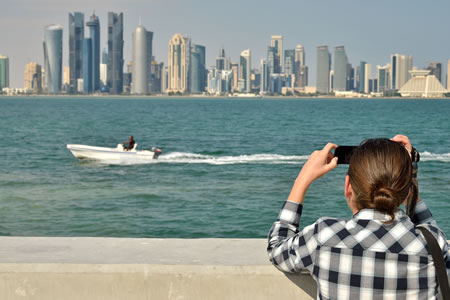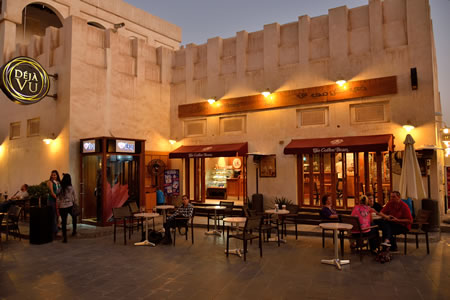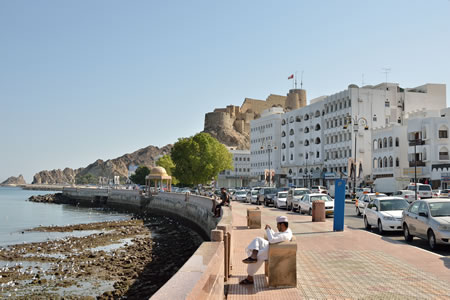English | Dutch |
|
| Soft desert sand and deep canyons | |
Manama (Bahrain) to Dubai (United Arab Emirates), January 2013
|
|
| |
|
We start 2013 in Doha, the third city that we visit in the Arabian Gulf states after Kuwait and Bahrain. For us, it is clearly a two faced city. We stay this week in one of the poorer areas of Doha, where we are surrounded with employees from low wage countries. They flock to the Arabian Gulf to find a job that will enable them to send money back home. Men from the Indian Subcontinent live for years in a row crammed in small living quarters. Through the windows we can see how many people live in the same, small room. Sleeping in bunk beds and with little space to move, they don’t only give up their family life back home but also every sense of privacy. The other part of Doha has a completely different vibe. This is the image that Doha wants to project to the outside world, with its high skyscrapers in the most futuristic architecture. Hugging the coast, there is beautiful promenade called the corniche which is flanked with well maintained parks. The corniche is completely empty during the day, but when the sun sets, this is the place were families gather to get some fresh air. This is the country with the highest GDP per capita and this is clearly visible in the old souk of Doha. Years back, it seemed unavoidable that this old market would disappear in favour for modernity. This was until someone saw the tourist potential of a “real” Arabic souk. In the last decennia, the souk was restored in its old glory and has become a big success. The tourist shops, restaurants and water pipe bars are so immensely popular with Arabs and Western expats that the market area even expanded; all in traditional architecture. To make it look even more authentic, men are riding on horses through the streets. Behind them, walks an Indian man whose job is to remove all the horse’s droppings. Hence, it shouldn’t be too authentic! |
|
 |
|
Filming the skyline of Doha |
|
Doha is a nice city to spend a few days, but a week is more than enough. We were therefore glad that our visit coincided with the ATP tournament of Doha. This gave us the opportunity to see some important tennis players in action for a small entrance fee (4 Euro). Also during this tournament, it was clear that local people like to delegate hands-on work to their immigrant workforce. Many Arabs are involved in the organisation, but the actual work of pointing guests to their seats and making sure that they are silent is done by Filipinos and Indians. The Qataris are more at ease with the role as manager. See also the foto-impression: “Doha - Qatar's window to the World” From Doha, we flew to Muscat, the capital city of the Sultanate of Oman. Compared to the other countries that we visited on the Arabian Peninsular, Oman is a country that is less dependent on oil. Here you will see the Omanis still working in all layers of society. The work force of bus drivers, shop assistants and road builders is diverse. In Oman, there are also immigrants who try to earn some money to send home, but the Omanis aren’t afraid to work with their hands themselves. Perhaps this is because there isn’t enough oil to pamper all Oman nationals, but for us it is much more interesting to travel in a country where you see the local people still walking on the streets. Oman has a lot to offer to its visitors, with incredible landscapes and rough nature as its main draw cards. To make the most of our time in Oman, we hired a 4WD car to practice our off road skills. The word “amazing” describes it all. We enjoyed every single minute of it; starting our days as the sun came up and parking the car only after it went down again. The landscapes of Oman are very divers, which makes it possible to enjoy sand dunes on one day and to look out over immense canyons on the next. The best thing about visiting Oman, is that the entire country is very accessible. While in most countries these kinds of nature phenomenon are protected in national parks, in Oman it is possible to visit these parts on your own. Because of the low number of visitors, this is still sustainable, but it means that visitors have to act responsible. It is expected that people stick to the existing off road paths to prevent flora from being damaged. Paris-Dakar like scenes of jeeps speeding through villages are also not acceptable, as well as skimpy clothed men and women who parade through the mainly Muslim villages. Our trip through Oman was certainly the sole highlight of our trip to the Arabian peninsular. For extensive coverage of our experiences in Oman, please look at our photo impression: “Oman - exceptionally beautifull”. | |
 |
|
One of Oman's pretty canyons |
|
| For the time being, our last destination during this trip to the Arabian Peninsular is the United Arab Emirates. Yemen and Saudi Arabia are still high on our wish list, but we have to save that for another time. From Muscat we went to Dubai by bus, a city of which we had high expectations. Dubai is the city that catches the news headlines with everything glitzy and glamorous, so we liked to see it with our own eyes. This is the city that wants to have the biggest and best of everything, so the tallest building in the world stands side-by-side with the largest mall in the world. The most striking feature of Dubai, however, is in our point of view the enormous amount of Russians on the streets. Many live here for certain periods of the year, while others come here for a short break from the cold Russian winter. The number of fur shops is remarkable for a dessert country and men who come from the former Soviet Union are hanging around on the street corners. They whisper something in the ear of every Russian who passes by. Whether they try to sell alcohol, drugs or illegal fur is unclear to us, but it is certainly something that isn’t legal. However, we haven’t seen any Russian accepting the offer, but regarding the number of guys roaming the streets there must be a market for the things that they have to offer.
When people ask us whether Dubai is worth a visit, we find it a difficult to answer. It’s a nice city to relax for a couple of days and to enjoy world class shopping, dining and amusement parks. For us, however, it isn’t a very atmospheric city in which you feel in the heart of Arabia. In the United Arab Emirates there live four times as many immigrants as there live Emiratis, so it isn’t strange that the streets don’t look Arabic anymore. Within the Emirati families, Arabian culture still seems to be very traditional, but as a visitor it is difficult to get a feeling of it. This is a disadvantage of all the Gulf States that we visited so far, except Oman. If we want to be among de Filipino’s, Indians and Pakistani we can go to their respective countries. Eating authentic Indian food is great, but this is not the reason to come to the Arabian Gulf. In the United Arab Emirates, we will visit three other places before we leave the Arabian Peninsular. Slowly, we start preparing ourselves for our visit to Iran and Central Asia. We are glad that we have an impression of Kuwait, Bahrain, Qatar, Oman and the United Arab Emirates, but we are also looking forward to the new part of our trip. In Iran and Central Asia we expect to enjoy more of the local daily live that happens on the street. The visa for Iran and Uzbekistan are organized, so in a short while we will know whether our expectations are correct. | |
 |
|
An expensive and weak cup of coffee at The Coffee Bean in Doha's souk |
|
 |
|
Waiting for FlyDubai's flight from Doha to Muscat |
|
 |
|
The boulevard of Mutrah (Muscat) |
|
 |
|
Desert colours in north-eastern Oman |
|
 |
|
Endless dirt tracks cross the Omani desert |
|
| <Previous weblog> | |